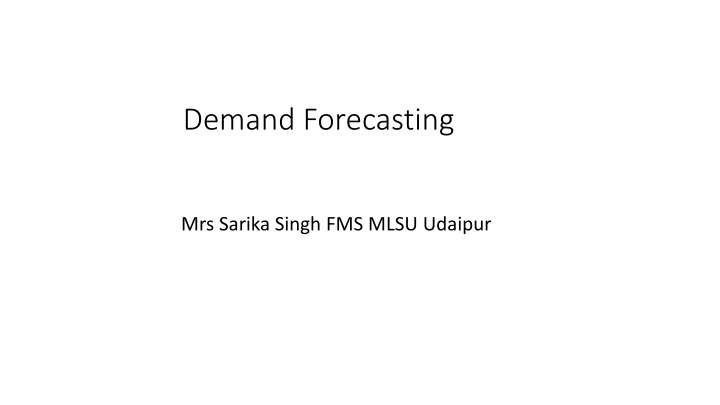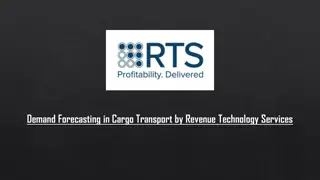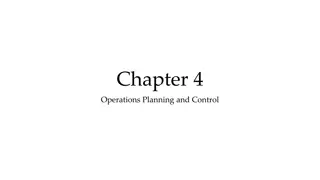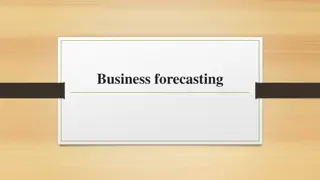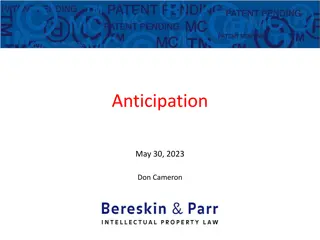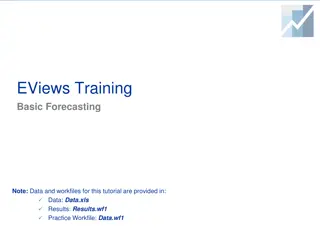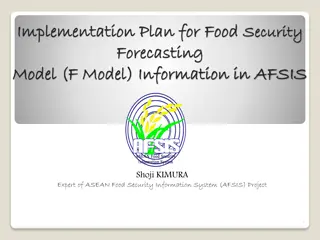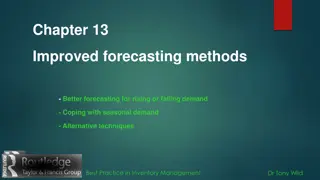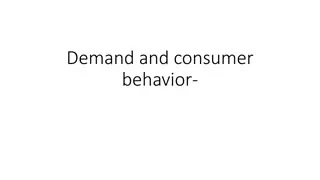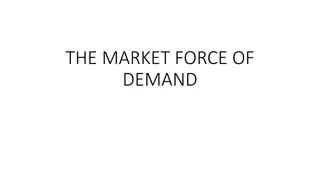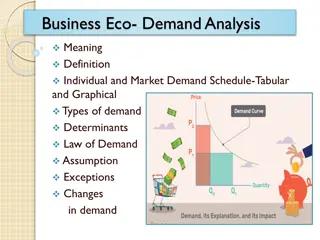Demand Forecasting - Systematic Process for Future Anticipation
Demand forecasting involves anticipating future product and service demand under various forces. Accurate forecasting is crucial for production planning, resource management, and pricing decisions. Qualitative techniques like consumer surveys are commonly used for short-term forecasting.
Download Presentation

Please find below an Image/Link to download the presentation.
The content on the website is provided AS IS for your information and personal use only. It may not be sold, licensed, or shared on other websites without obtaining consent from the author.If you encounter any issues during the download, it is possible that the publisher has removed the file from their server.
You are allowed to download the files provided on this website for personal or commercial use, subject to the condition that they are used lawfully. All files are the property of their respective owners.
The content on the website is provided AS IS for your information and personal use only. It may not be sold, licensed, or shared on other websites without obtaining consent from the author.
E N D
Presentation Transcript
Demand Forecasting Mrs Sarika Singh FMS MLSU Udaipur
Meaning Meaning & & Definition Forecasting Forecasting Definition of of Demand Demand Demand forecasting is a systematic process that involves anticipating the demand for the product and services of an organization in future under a set of uncontrollable and competitive forces. Accurate demand forecasting is essential for a firm to enable it to produce the required quantities at the right time and arrange well in advance for various inputs.
Meaning Meaning & & Definition Definition of of Demand Demand Forecasting Forecasting In the words of Cundiff and Still, Demand forecasting is an estimate of sales during a specified future period based on proposed marketing plan and a set of particular uncontrollable and competitive forces. Demand forecasting enables an organization to take various business decisions, such as planning the production process, purchasing raw materials, managing funds and deciding the price of the product . An organisation can forecast demand by making own estimates or taking the help of specialized consultants or market research agencies
METHODS OF DEMAND METHODS OF DEMANDFORECASTING FORECASTING
A) Qualitative Qualitative Techniques/ Method Method -In this method, the opinion of the buyers, sales force and expert could be gathered to determine the emerging trend in the market. - Suited for short term demand forecasting. -Demand forecasting for new product can b made techniques. Techniques/ Opinion Opinion Polling Polling by qualitative The opinion polling methods of demand forecasting are of following kinds: 1) Consumer Survey Method 2) Sales Force Opinion Method 3) Delphi Method
1) Consumer Consumer Survey SurveyMethod Method Survey method is one of the most common and direct methods of forecasting demand in the short term. This method encompasses the future purchase plans of consumers and their intentions. In this method, organization conducts surveys determine the demand for their existing products and services and anticipate the future demand accordingly. an to with consumers Survey method include: a) Complete Enumeration Survey b) Sample Survey and TestMarketing c) End Use
1) ) Consumer Consumer Survey SurveyMethod Method a) Complete Enumeration Survey: In this method records the data & aggregates of consumers If the data is wrongly recorded than Demand Forecasting going wrong, than this method will be totallyuseless. b) Sample Survey & TestMarketing: Only few customers selected and their views collected. Based on the assumption that the sample truly represents the population. This method is simple and does not costmuch The main disadvantage is that the sample may not be a true representation of the entire population.
1) Consumer Consumer Survey SurveyMethod Method c) End Use Method: This method Focuses on Forecasting the demand for intermediary Goods. Under this method, the sales of a Product are projected through a survey of its end users. Example: Milk is a commodity which can be used as an intermediary good for the production of ice cream, and other dairy products.
2) Sales Sales Force Force Opinion OpinionMethod Method -In this method , instead of consumers, the opinion of the opinion of salesman is sought. -It is also referred as the grass root approach as it is a bottom- up method that requires each sales person in the company to make an individual forecast for his or her particular sales territory. - The composite of all forecasts then constitutes the sales forecast for the organisation. -The main advantage is that the collecting data from its own employees is easier for a firm than to do it from external parties. -The main disadvantage is that the sales force may give biased views as the projected demand affects their future job prospects.
3) Delphi DelphiTechnique Technique This method is also known as expert opinion method. In this method seeks the opinion of groups of Expert through mail about the expected level of Demand. The identity of expert is kept secret. These opinion exchanged among the various experts and their reactions are sought and analyzed. The process goes on until some sort of unanimity is arrived at among all the experts. The advantage is that the forecast is reliable as it is based on the opinion of people who know the product very well. The disadvantage is that the method is subjective and not based on scientific analysis.
B) Quantitative Quantitative Techniques/ Analytical Analytical Methods Methods These are forecasting techniques that make use of historical quantitative data. Techniques/ Statistical Statistical or or A statistical concept is applied to the existing data in order to generate the predicted demand in the forecast period. The statistical methods, which are frequently used, for making demand projection are: 1) Trend Projection Method 2) Barometric Method 3) Regression Method 4) Econometric Method
1) Trend Trend Projection ProjectionMethod Method -An old firm can use its own data of past years regarding sales in past years. -These data are known as time series of sales. -Assumes that past trend will continue in future. -Past trend is extrapolated (generalised). The trend can be estimated by using any one of the following methods: a) Graphical Method b) Least Square Method c) Time Series Data d) Moving Average Method e) Exponential Smoothing
1) Trend Trend Projection ProjectionMethod a) Graphical Method: A trend line can be fitted through a series graphically. The direction of curve shows the trend. The main drawback of this method is that it may show the trend but not measure it. Method b) Least Square Method:
1) Trend Trend Projection ProjectionMethod Method c) Time Series Data: Data collected over changes in price, income, and other relevant influencing demand for a commodity. Time series analysis relates to the determination of changes in a variable in relation to time. a period of time recording historical variables d) Moving Average Method: The moving average of the sales of the past years is computed. The computed moving average is taken as forecast for the next year or period. This is based on the assumption that future sales are the average of the past sales.
1) Trend Trend Projection ProjectionMethod Method e) Exponential Smoothing: It uses a weighted average of past data as the basis for a forecast. The procedure gives heaviest weight to more recent information and smaller weights to observations in the more distant past. The reason forthis is that the future is more dependent on the recent past than on the distant past.
2) Barometric BarometricMethod Method In barometric method, demand is predicted on the basis of variables occurring in the present. This method is also used to predict various economic indicators, such as saving, investment, and income. This method was introduced by Harvard Economic Service in 1920 and further revised by National Bureau of Economic Research (NBER) in 1930s. This technique helps in determining the general trend of business activities. For example, suppose government allots land to the XYZ society for constructing buildings. This indicates that there would be high demand for cement, bricks, and steel. The main advantage of this method is that it is applicable even in the absence of past data. past events or key
3) Regression RegressionMethod Method This method is undertake variables where correlation appears to exist. to measure the relationship between two E.g. The age of the air condition machine and the annual repair expenses. This method is purely based on the statistical data.
4) Econometric EconometricMethod It is assumed that demand is determined by one or more population, etc. Method variables. E.g. income, Demand is forecast on the basis of systematic analysis of combining economic theory with mathematical and statistical tools. economic relations by
Importance Importance of of Demand DemandForecasting Forecasting 1) Production Planning: Expansion of output of the firm should be abased on the estimates of likely demand, otherwise overproduction and consequent losses may have to be faced. there may be 2) Sales Forecasting: Sales forecasting is based on the demand forecasting. Promotional efforts of the firm should be based on the sales forcasting
Importance Importance of of Demand DemandForecasting Forecasting 3) Control of Business: For controlling the business, it is essential to have a well conceived budgeting of costs and profits that is based on the forecast of annual demand. 4) Inventory Control: A satisfactory control of business inventories, raw materials, intermediate goods, finished product, etc. requires satisfactory estimates of the future requirements which can be traced through demand forecasting.
Importance Importance of of Demand DemandForecasting Forecasting 5) Economic Planning and Policy Making: The government can determine its import and export policies in view of the long-term demand forecasting for various goods in the country. 6) Growth and Long- term Investment Programs: Demand forecasting is necessary for determining the growth rate of the firm and its long-term investment programs and planning.
